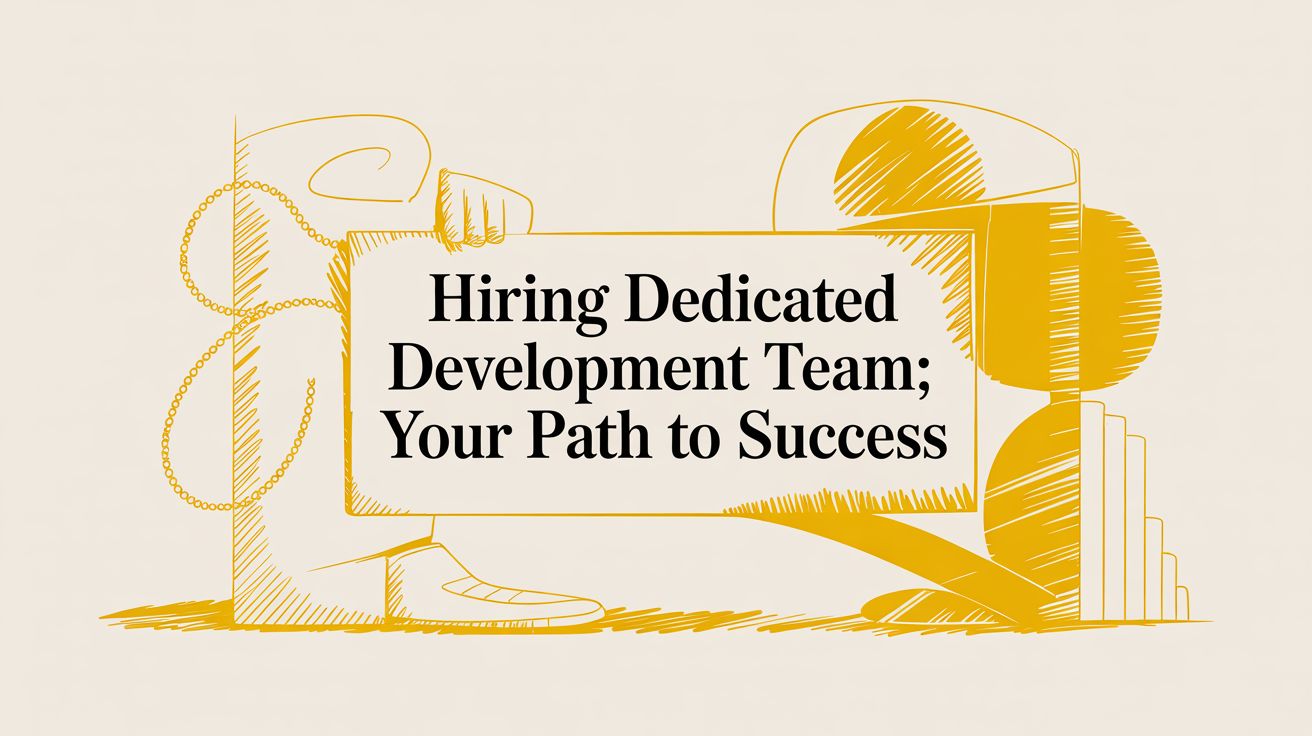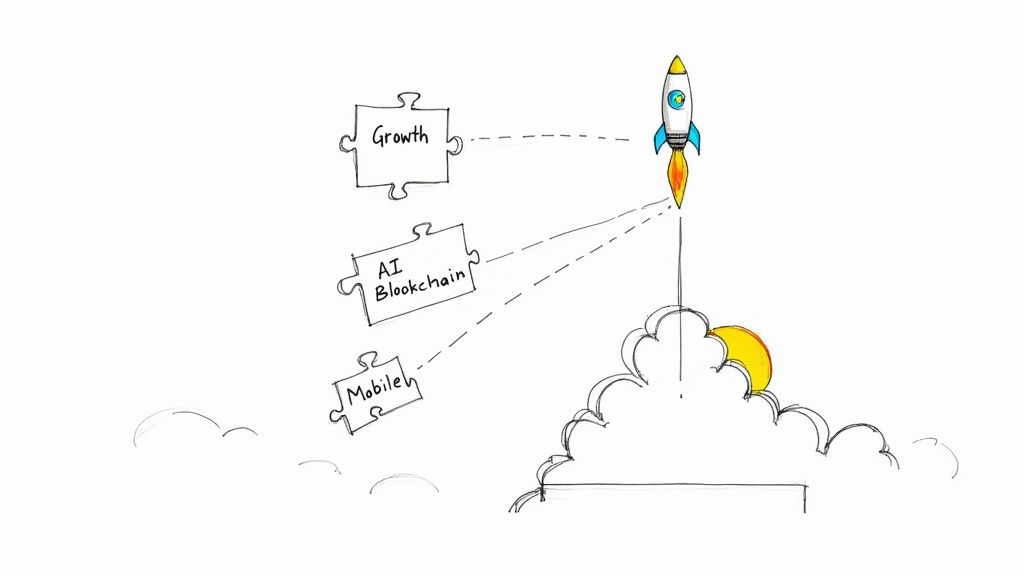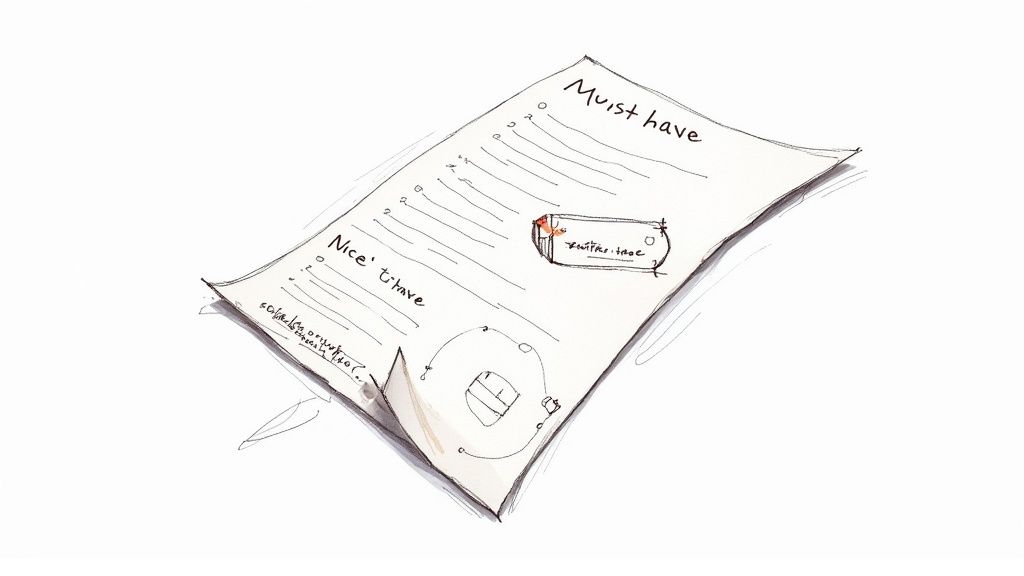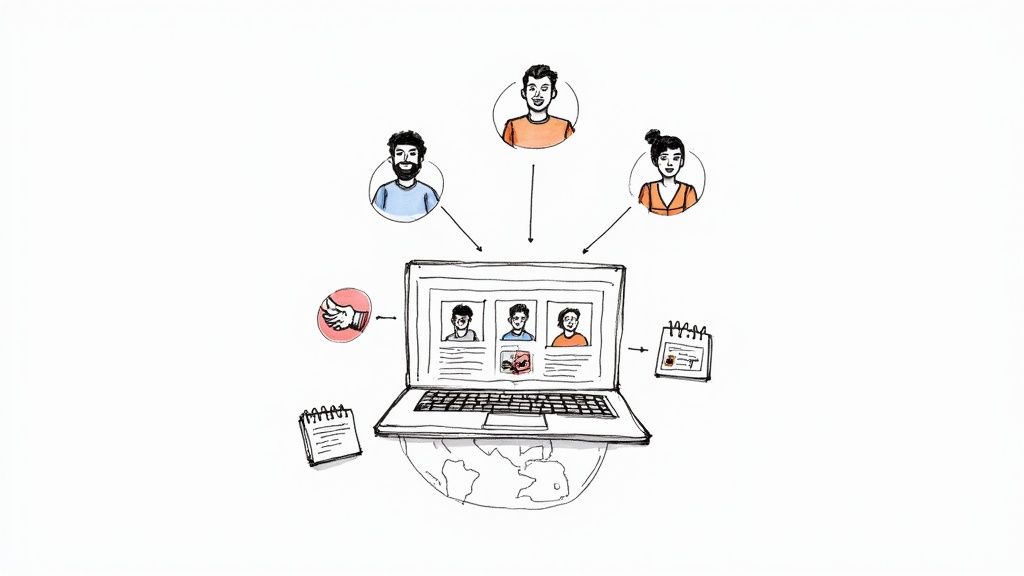hiring dedicated development team: Your path to success

Opting for a dedicated development team is more than just a cost-saving measure; it's a strategic decision that gives companies access to specialized skills, helps them get products to market faster, and allows them to scale with incredible agility. This model provides a team that is 100% committed to your project, operating as a true extension of your in-house crew. It’s a game-changer for startups that need to move fast and for established enterprises looking to innovate without derailing their core operations.
Why Smart Companies Hire Dedicated Development Teams

Bringing an outside team into the fold might sound complicated, but the strategy behind it is surprisingly simple—and powerful. It's all about gaining a competitive advantage by getting the exact skills you need, right when you need them. We're not just talking about farming out tasks. This is about embedding a team of experts into your workflow who are fully aligned with your long-term vision.
It’s no surprise this model has taken off. In fact, 92% of G2000 companies and 37% of small businesses now use this approach to bolster their capabilities. It enables a company to bring together specialists who are laser-focused on their project, which is absolutely critical for hitting tight deadlines and maintaining high quality.
Think of it as having an elite workforce on-demand, letting you pull from a global talent pool and resize your team as your project evolves. If you're curious about the data behind this trend, you can check out the full research on dedicated teams and see how it’s helping businesses grow.
Unlocking Strategic Advantages
The real beauty of a dedicated development team boils down to agility, expertise, and focus.
Imagine a startup aiming to launch its Minimum Viable Product (MVP). By using a pre-vetted, cohesive dedicated team, they can launch months faster than if they had spent that time slogging through a traditional recruitment process. They skip the overhead of HR, benefits, and office space, pouring every resource directly into building a great product.
For larger companies, the benefits look a little different but are just as significant. An enterprise can spin up a dedicated team to tackle an experimental R&D project—say, an AI-powered analytics tool—without pulling its best developers off core products. This creates a low-risk environment for innovation that doesn't disrupt day-to-day business.
The real power of a dedicated team is focus. When a group of developers lives and breathes your project every day, they build deep product knowledge that translates into better problem-solving, smarter feature implementation, and a higher-quality final product.
To get a clearer picture, let's compare this model against traditional in-house hiring.
| Factor | Dedicated Development Team | In-House Team |
|---|---|---|
| Speed to Hire | Very fast (weeks) | Slow (months) |
| Cost | Lower operational overhead | Higher (salaries, benefits, office) |
| Access to Talent | Global talent pool | Limited to local market |
| Scalability | High; easy to scale up or down | Low; rigid and slow to change |
| Management | Shared responsibility | Fully managed by you |
As you can see, the dedicated team model offers a level of flexibility and efficiency that’s tough to match with conventional hiring.
Comparing Models For Clarity
It's also important to understand how this differs from other popular outsourcing models. Unlike project-based outsourcing, where a vendor works on a fixed scope, a dedicated team is built to handle evolving requirements and pivots with ease.
It's also a step beyond simple staff augmentation, where you're just hiring individual developers to fill seats. A dedicated team is a complete, self-managed unit designed to take ownership. We explore this in more detail in our guide on staff augmentation vs outsourcing.
Ultimately, bringing on a dedicated team is a strategic play. It’s for companies that want to accelerate growth, access top-tier talent, and maintain a sharp focus on their core business goals. It's a modern, efficient solution for anyone who needs to build outstanding software without the headaches of old-school hiring.
Defining Your Project Needs Before You Hire

Before you even think about starting a conversation with a potential partner, you need to get your own house in order. Jumping into discovery calls without a clear plan is a surefire way to waste everyone's time and end up with a team that isn't the right fit. Honestly, this prep work is the most crucial part of hiring a dedicated development team that will actually deliver on your vision.
Forget about writing a massive, hundred-page requirements document that will just gather dust. Your goal is a lean, focused project brief. Think of it as your North Star—a document that clearly outlines what success looks like and what you'll need to get there.
Doing this work upfront helps you attract the right kind of partner. It shifts the conversation from vague ideas to concrete plans, allowing them to give you a proposal that’s grounded in reality.
Differentiating Must-Haves From Nice-to-Haves
First things first: you have to be ruthless about prioritizing features. At the start of a project, every idea feels critical, but that's a fast track to scope creep and a busted budget. A simple framework can help you separate what’s essential now from what can wait.
I like to use the house-building analogy. Your foundation, walls, and roof are the must-haves—the core functionality your product can't live without. A swimming pool or a home theater? Those are nice-to-haves. They’re great, but you can always add them later.
Let’s say you’re building a new project management app. Here’s how you might break it down:
- Must-Have: User registration, creating a new task, assigning tasks, and setting deadlines.
- Nice-to-Have: GANTT chart views, calendar integrations, AI-driven task suggestions, or customizable themes.
This exercise brings immediate clarity. It tells a potential partner exactly what your immediate focus is and gives you a clear roadmap for your Minimum Viable Product (MVP). You launch with a strong, focused product, not a bloated one. For more on this, our guide on how to define project scope can walk you through the nitty-gritty.
Pinpointing Specific Technical and Soft Skills
Saying you need a "mobile developer" is basically useless. It's like telling a recruiter you need "an athlete"—for what sport? In what position? When it comes to skills, specificity is everything.
Get granular about the exact technologies, frameworks, and experience levels you need. Don't just list a role; define the person who will fill it.
Example: You're not looking for a "back-end developer." You need a "Senior Python developer with at least 3 years of experience building and maintaining RESTful APIs using Django REST Framework, plus proven experience in PostgreSQL database optimization."
That level of detail acts as a powerful filter, weeding out unqualified candidates from the start. It also shows potential partners that you know what you’re talking about. And don't forget the soft skills—they're just as vital for making a remote collaboration work.
Establishing the Ground Rules for Collaboration
Beyond the code, you need to define how you'll work together. These are the logistical and cultural details that often get overlooked but can make or break a partnership. If you're not aligned on these, you're in for a world of friction.
Part of this is also understanding staff augmentation and other engagement models. Knowing your options can influence the kind of team and collaboration style you're looking for.
Be sure to think through these key questions:
- Time-Zone Overlap: What’s the bare minimum of overlapping work hours you need for stand-ups and quick chats? A 4-hour overlap is a good rule of thumb.
- Communication Protocols: Where will you live? Slack? Jira? Trello? What’s a reasonable response time for non-urgent questions?
- Team Autonomy: How much freedom will the team have? Do they need to get approval for every minor technical choice, or can they own their decisions?
- Reporting Structure: Who is their go-to person on your end? How often do you expect progress reports—daily, weekly?
Nailing down these answers from the outset sets clear expectations and builds a foundation of trust. It ensures that when you start hiring a dedicated development team, you’re not just finding people who can code; you’re finding a genuine partner.
How to Find and Vet Your Ideal Development Partner

Alright, you’ve got a solid project brief. Now for the hard part: finding the right people to build it. This isn't just about scrolling through agency websites. It’s an investigation. You're looking for a team that gets your vision, fits your budget, and won't drive you crazy to work with.
The goal here is to cut through the marketing fluff and see what a potential partner is really made of.
Sites like Clutch or GoodFirms are fine for building an initial list, but their aggregate scores don't tell the whole story. The real work begins when you start digging into a company's past projects and what their clients actually have to say.
Go Beyond Surface-Level Reviews
Reviews give you a general vibe, but case studies are where you find the proof. Don't just skim them—tear them apart. Zero in on projects that feel like yours in terms of industry, technical complexity, and the tools they used.
A good case study shows you how a team solved a real business problem, not just what they built. If they built a fintech app, for instance, the case study should explain how they navigated tricky security protocols or integrated with specific payment gateways, not just show you a few slick screenshots.
As you read, look for these key elements:
- The Problem: Did they actually grasp the client’s core challenge?
- The Solution & Tech: Was their technical approach logical? Is their tech stack a good match for what you need?
- The Process: How did they run the project? Did they mention specific methodologies, like Agile?
- The Results: What did they actually achieve for the business? Look for hard numbers, like "drove a 30% increase in user engagement" or "cut cart abandonment by 15%."
Questions That Reveal True Character
Once you’ve narrowed down your list, it's time to get on some calls. This is where you test for more than just technical skill. You’re feeling out their communication style, how they think through problems, and whether their project management is a well-oiled machine or a chaotic mess. To learn more about attracting the right talent, it's worth exploring some modern candidate sourcing techniques.
Ditch the generic interview questions. Try these instead:
- “Walk me through a project that went off the rails. How did you get it back on track?” This is a test of honesty and accountability. A great partner won’t pretend everything is always perfect. They'll be open about past struggles and show you they have a clear process for fixing things.
- “How do you handle scope creep when a new feature is requested mid-sprint?” Their answer tells you everything about their discipline. You want to hear about a structured process—assessing impact, explaining the trade-offs, and getting your sign-off before anything changes.
- “Describe your client onboarding process.” A mature team will have a battle-tested plan for getting up to speed, setting up tools, and integrating with your team. A vague answer here means a bumpy start.
A partner’s willingness to be transparent is a critical sign of a healthy future relationship. If they are evasive about challenges or unwilling to connect you with past clients, consider it a major red flag. True confidence comes from a history of successful, referenceable work.
Spotting Red Flags Early
Vetting isn't just about finding the good stuff; it's about dodging bullets. You need to be on the lookout for warning signs before any contracts are signed.
Be cautious if a potential partner shows any of these behaviors:
- Vague Pricing Models: If they can't give you a straight answer on costs and what’s included, you’re setting yourself up for surprise bills. A trustworthy partner will provide a clear, itemized breakdown.
- Unwillingness to Provide References: This one is simple. A team that's proud of their work will be eager for you to speak with their clients. Any hesitation is a huge warning.
- Overpromising and Under-questioning: A partner who says "yes" to everything without asking tough questions is a recipe for disaster. You want a consultant who challenges your assumptions to make the final product better, not a yes-man.
- High Employee Turnover: Ask about the average tenure of their developers. If they have a revolving door, it can signal management issues and lead to project delays and inconsistent quality.
Finding the right partner takes time and effort, but it’s one of the most important investments you’ll make. By digging deeper and asking the right questions, you set the stage for a partnership built on trust. This careful vetting is the most critical step when you hire a dedicated development team that will ultimately feel like a true extension of your own.
Getting the Paperwork Right: Your Project's Blueprint for Success
Once you’ve found a team that feels like the right fit, it’s time to get everything down on paper. A solid contract isn’t just a formality; it’s the bedrock of your entire partnership. It’s where you turn vague discussions into concrete commitments, setting clear expectations and creating a safety net for everyone involved.
Think of it this way: without a detailed agreement, you're building on assumptions. And in software development, assumptions are where budgets go to die and timelines fall apart. This document is your best tool for making sure you and your new team are completely aligned on scope, deliverables, and payment from day one.
Choosing the Right Engagement Model
One of the first things you'll hash out is the financial structure. The two most common models you'll encounter are Fixed-Price and Time & Materials (T&M). Each has its place, and the right choice depends entirely on what you're building.
A Fixed-Price contract is exactly what it sounds like: you agree on a specific scope of work for a single, upfront price. This works beautifully for small, well-defined projects where the requirements are set in stone—think a simple marketing website or a single-feature MVP. You get total budget predictability, but it leaves almost zero room for changes without going back to the negotiating table.
On the other hand, the Time & Materials (T&M) model is the go-to for most dedicated team arrangements. Here, you pay for the actual hours the team works on your project. This approach gives you incredible flexibility to iterate, pivot, and adapt your product based on real-world feedback. For complex, long-term projects where the final scope is still evolving, T&M is almost always the smarter choice.
For most companies bringing on a dedicated development team, the T&M model just makes sense. It's built for the kind of agile, iterative work that modern software requires, giving you the freedom to improve your product on the fly instead of being locked into an outdated plan.
Decoding the Service Level Agreement (SLA)
The Service Level Agreement, or SLA, is where the real substance of your contract lies. It moves beyond the price tag to define the actual standards of service, performance metrics, and responsibilities your partner is committing to. A vague SLA is a huge red flag. A detailed one is your guarantee of quality.
When you're reviewing the SLA, zero in on a few critical clauses. These are the non-negotiables that truly protect your business and its intellectual property.
Make sure your contract leaves no room for doubt on these points:
- Intellectual Property (IP) Rights: This is non-negotiable. The contract must state, in no uncertain terms, that 100% of the code and all related IP developed for your project belong exclusively to your company.
- Data Security and Confidentiality: Your new team will be handling sensitive information. The agreement needs to spell out their security protocols, how they manage data, and include a strong Non-Disclosure Agreement (NDA).
- Termination Clause: What happens if things just aren't working out? A clear termination clause should outline the notice period required and the process for a clean handover of all project assets, documentation, and code.
- Team Availability and Response Times: The SLA should define the team's core working hours, expected response times for emails and calls, and the plan for tackling critical bugs or system downtime.
Of course, a major reason companies go this route is the cost savings. Businesses can slash operational costs by up to 60% by choosing a dedicated team instead of hiring in-house. With average U.S. tech salaries soaring past $123,000, avoiding the long-term overhead of recruitment, benefits, and office space is a powerful financial move. You can discover more insights about team cost-effectiveness and see a detailed breakdown of the numbers.
Signing the contract is the final gate before the real work begins. By taking the time to choose the right engagement model and carefully vet the SLA, you’re laying a solid foundation for a productive and transparent partnership. It’s this upfront diligence that protects your investment and sets your project up for success right from the start.
Onboarding and Managing Your New Dedicated Team

The contract is signed, the team is assembled. It’s tempting to breathe a sigh of relief, but this isn't the finish line—it's the starting line. Those first few days and weeks are absolutely critical. They set the tone for the entire partnership, and a disorganized start can create friction that sticks around for months.
Successfully hiring a dedicated development team is only half the job. Now you have to bring them into the fold. The goal is to make them feel less like an outside vendor and more like a true extension of your own crew.
This kind of integration doesn't happen by magic. It takes a deliberate onboarding plan designed to build trust, spell out expectations, and get everyone marching in the same direction from day one.
Kicking Off With a Comprehensive Plan
Your very first move should be a solid kickoff meeting. This is way more than a quick meet-and-greet; it’s a strategic session to get everyone aligned on the project’s vision, its goals, and the nitty-gritty of how you'll work together.
By the end of this meeting, every single person on both sides should have a crystal-clear picture of what success looks like.
Your kickoff agenda needs to cover a few key things:
- Deep Dive into the Vision: Don't just read the project brief. Share the why. Talk about the customer pain points you're trying to solve and the business impact you’re aiming for. Get them invested.
- Role Introductions and Clarifications: Everyone introduces themselves and their role. This simple step prevents a ton of confusion later about who to ask for what, whether it's a technical question or a product decision.
- Tool and Access Setup: Make sure every single person has access to your project management tools (Jira, Trello, etc.), communication channels like Slack, and all the code repos. Don't let access issues be your first roadblock.
- Defining the 'Done' Criteria: Hammer out a shared definition of "done." Does a task need to be coded, tested, and deployed to staging to be complete? Getting this straight from the jump prevents countless arguments later.
A successful kickoff transforms a group of individuals into a cohesive unit. It’s the moment you stop being "the client" and "the vendor" and start becoming one team, united by a shared goal.
This initial meeting is your foundation. Skipping it is like trying to build a house without pouring the concrete first—it’s only a matter of time before things start to crumble.
Cultivating a One Team Culture Across Continents
One of the biggest pitfalls with a remote team is letting an "us vs. them" mindset creep in. You have to actively fight this by fostering a sense of shared ownership and camaraderie, even if you’re separated by thousands of miles.
A "one team" culture is built on small, consistent actions. For instance, create a dedicated, shared Slack channel for both your in-house and dedicated teams. Encourage some casual chatter alongside the work talk—it helps people build real connections.
Be inclusive. When you have a company-wide virtual town hall or celebrate a big win, make sure your dedicated team is invited to the party. These small gestures prove that you see them as genuine partners, not just hired guns. For a deeper look, check out these tips for managing remote teams which apply perfectly here.
Establishing a Productive Rhythm for Communication
Great management hinges on a communication cadence that provides clarity without turning into micromanagement. It’s all about establishing a predictable rhythm that keeps everyone in sync.
Here’s a simple but powerful structure that works wonders:
- Daily Stand-ups: Keep them short and sweet (15 minutes, max). Everyone shares what they did yesterday, what they're doing today, and any blockers. This isn't a status report for the boss; it's a sync-up for the team.
- Weekly Progress Reviews: This is a higher-level check-in to see how the past week's work stacks up against sprint goals and to plan for the week ahead. It’s the perfect time to tackle bigger-picture issues.
- Regular Demos: Set up recurring sessions for the team to show off the new features they’ve built. This keeps stakeholders in the loop and gives everyone a chance to provide valuable, early feedback.
This kind of structure makes communication frequent and purposeful. It helps you catch misunderstandings before they snowball and keeps the project moving forward, ensuring your partnership with your new team is a smooth and productive one.
What Can Go Wrong When Hiring a Team? (And How to Avoid It)
Bringing a dedicated development team on board can be a game-changer, but it’s a path riddled with potential traps. Frankly, learning from the mistakes others have made is the quickest way to get it right yourself. Sidestepping these common blunders isn't just about protecting your budget; it’s about building a partnership that actually works and delivers something you're proud of.
Too many companies stumble into the same predictable pitfalls. They get dazzled by a low price tag, jump in without defining what they actually want to build, or treat their new team like disconnected outsiders. These missteps can quickly turn a promising partnership into a source of constant frustration and wasted cash.
The Lure of the Lowest Bid
It’s so tempting. You get a few proposals, and your eyes immediately drift to the cheapest one. But I’ve seen this play out time and time again: choosing a development partner just because they have the lowest price is one of the most frequent—and costly—mistakes you can make. That old saying, "you get what you pay for," is painfully accurate in the world of software.
An unusually low bid is almost always a red flag for deeper problems. It could signal a team of junior developers with very little real-world experience or an agency with a revolving door of talent. Worse, it might mean hidden costs are waiting to pop up later, turning that initial "bargain" into a budget nightmare.
A low price often means high risk. Instead of fixating on the hourly rate, look at the total value a partner brings to the table. Their experience, communication style, and proven track record are far better predictors of success than a rock-bottom price.
Think about it this way: a startup I know of chose a partner offering rates 30% lower than anyone else. At first, things seemed great. But soon enough, they realized the code was a mess—buggy, poorly written, and impossible to scale. The time and money they ended up spending to hire a new, more experienced team to clean it all up completely wiped out any of those initial savings.
The Chaos of Unclear Requirements
Another massive mistake is starting the hunt for a team without a crystal-clear vision of what you need. If you can't explain your project goals, technical needs, and what a successful outcome looks like, how can you possibly expect an outside team to build it for you? Vague requirements are a direct path to endless revisions, scope creep, and a final product that just misses the mark.
Before you even start talking to potential partners, you have to do your homework. A well-defined project brief is your single best defense against ambiguity. This initial clarity ensures that any team you bring on is aligned with your vision from the very first conversation. The whole process of hiring a dedicated development team has to start with this internal focus.
There's a reason this model has become a global trend—the benefits are huge. In fact, over 60% of companies have outsourced software development to cut costs and tap into a bigger talent pool. When you consider that a senior developer in the U.S. can easily cost over $200,000 a year, the savings become obvious. You can discover more insights about the benefits of dedicated teams on codiant.com to see why so many businesses are making this strategic move.
Forgetting to Actually Integrate Your Team
Finally, one of the most critical errors is treating your dedicated team like a third-party vendor. They aren't just a line item on an invoice; they are an extension of your own crew. When you fail to bring them into your company culture, your communication channels, and your daily workflow, you create an "us vs. them" dynamic.
That kind of disconnect kills collaboration. It leads to poor communication, a total lack of shared ownership, and a team that never feels truly invested in your project's success.
To get this right, make integration a priority from day one:
- Bring them into the fold: Invite them to your virtual company meetings, add them to your main Slack or Teams channels, and share your wins with them.
- Give them a go-to person: Assign a dedicated point of contact on your internal team. This streamlines communication and helps build real relationships.
- Create a "one team" vibe: Actively encourage collaboration and conversation between your in-house staff and your dedicated developers.
By steering clear of these common mistakes, you set yourself up for a strong, productive partnership. You’ll move beyond simply outsourcing tasks and start building a genuine team that is committed to helping you win.
Got Questions? We've Got Answers
When you're thinking about bringing on a dedicated development team, a few questions always seem to pop up. Let's tackle some of the most common ones I hear from business leaders, so you can move forward with a clear head.
So, What’s the Real Cost of a Dedicated Team?
This is the big one, and the honest answer is: it depends. The biggest factor is geography. If you're looking at talent in hot spots like Eastern Europe or Latin America, you can expect developer rates to fall somewhere in the $35 to $75 per hour range. That's a different ballpark compared to North American rates, which are significantly higher.
Your total monthly bill will also hinge on the size and specific skills of your team. The good news is that most vendors roll everything into a fixed monthly fee. This usually covers all the salaries and overhead, which makes budgeting way more predictable. No surprise invoices.
Dedicated Team vs. Staff Augmentation—What's the Difference?
It's easy to get these two mixed up, but they're built for completely different situations.
Think of hiring a dedicated development team as getting a fully-equipped, self-sufficient crew. The vendor provides a complete unit—developers, a project manager, QA specialists—and they work only on your project. They take ownership from start to finish.
Staff augmentation is more like plugging a hole in your existing team. You're hiring individuals from a vendor to fill specific skill gaps, and they slot right into your in-house workflow. The key difference? You manage them directly, just like any of your other employees.
The bottom line: Go for a dedicated team when you need a managed, all-in-one solution for a whole project. Choose staff augmentation when you just need a few extra hands with specific skills for your current team.
How Do You Actually Deal With Time Zones and Communication?
This is where a little bit of planning goes a long way. The most successful remote teams I've worked with insist on a mandatory overlap of 3 to 4 working hours every day. This isn't just a nice-to-have; it's essential for those quick back-and-forths, daily stand-ups, and sorting out problems in real-time.
You also need a clear game plan for your tools. We're talking about using Slack for the day-to-day chatter and something like Jira to keep everyone on the same page about tasks and progress. A solid rhythm of daily check-ins and weekly reports ensures no one is left in the dark, no matter where they are in the world.
Who Owns the IP and the Code?
This is a deal-breaker, plain and simple. Your contract needs to spell it out in black and white: your company owns 100% of the intellectual property and every single line of code the team writes for you.
Any reputable partner will have this as a standard clause in their agreement. It's how you protect your investment and your business's future. Make sure this is crystal clear before you sign anything. The code they build is your asset, and the paperwork needs to reflect that.